Exploring the Aquamarine Stone: A Comprehensive Overview
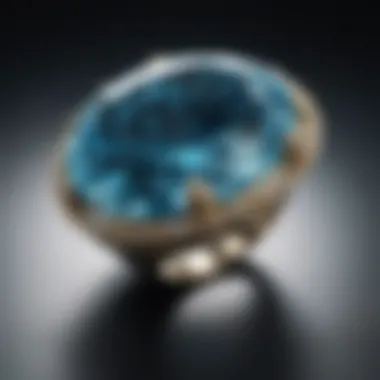
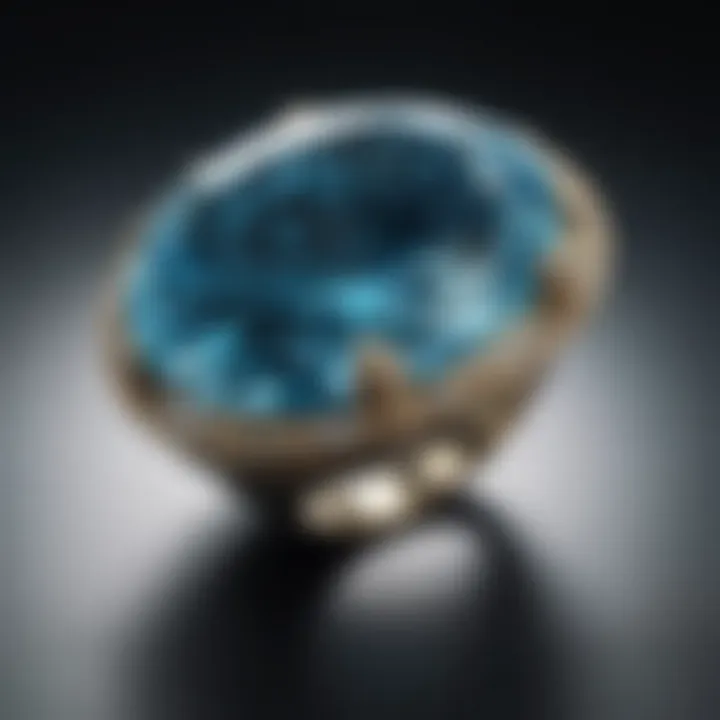
Intro
Aquamarine, often associated with tranquility and calmness, possesses a unique allure that captivates both seasoned collectors and casual aficionados. This gemstone, with its mesmerizing blue shades reminiscent of clear ocean waters, offers more than just aesthetic pleasure. In this exploration, we will journey through the various dimensions of aquamarine, from its geological origins to its significance in various cultures, touching on properties that make it stand out in the world of gemstones.
Gemstone Overview
Definition and Origins
Aquamarine is a variety of the mineral beryl, family that includes other gemstones such as emerald. The name itself derives from the Latin words "aqua" meaning water and "marina" meaning of the sea, perfectly capturing its enchanting hues that range from pale blue to deep teal. Found in nature, primarily in regions like Brazil, Nigeria, and Madagascar, the stone is often a product of granite formations. Here, the combination of beryllium, aluminum, and other elements leads to the formation of this stunning gem.
Historical Significance
Throughout history, aquamarine has held a special place in various cultures. Ancient Romans believed it was a treasure of mermaids, often used by sailors as a talisman for good fortune during voyages. It was also revered by the Egyptians, who crafted it into jewelry and amulets that were thought to provide protection. Additionally, during the Middle Ages, aquamarine was thought to have healing properties, particularly for ailments related to the throat. This fascinating history adds layers of depth to its significance, intertwining the gemstone with myths, legends, and healing traditions across civilizations.
Gemstone Properties
Hardness and Durability
When considering gemstones, one critical aspect is hardness. Aquamarine ranks between 7.5 to 8 on the Mohs scale, making it relatively durable. This toughness, combined with its stunning appearance, makes it suitable for everyday wear in various jewelry forms, from rings to necklaces. However, it is still essential to treat it with care to avoid any scratches or chips, as softer materials can wear down over time.
Color and Clarity
The most striking feature of aquamarine is undoubtedly its color. The hues can range from a subtle, almost colorless tinge to an intense blue with green undertones. It is important to note that the finest quality aquamarine showcases a vivid blue color and excellent clarity. Many stones in the market today undergo treatments to enhance these attributes, emphasizing the need for consumers to feel educated about what they're purchasing.
"The deeper the color of an aquamarine, the rarer and more valuable it becomes, displayed like a glimmering piece of the ocean itself."
The clarity of aquamarine is also noteworthy. Unlike many gemstones that often feature inclusions or impurities, high-quality aquamarine tends to be nearly flawless, allowing for its brilliant light reflection. This transparency makes it particularly attractive for those looking to invest in unique jewelry pieces or seek out stones for collection.
In this gemstone's story, factors such as care guidelines and variations in types will later come into play, ensuring a comprehensive understanding of aquamarine's multifaceted charm.
Preface to Aquamarine
When it comes to gemstones, aquamarine is a real gem among gems, particularly revered for its distinct bluish-green hues that conjure images of tranquil seas and clear skies. This article unveils the beauty and significance behind aquamarine, exploring its properties, historical context, and cultural relevance. Understanding aquamarine not only enriches the knowledge of gemstone enthusiasts and collectors, but also sheds light on the aesthetics of jewelry design.
The importance of this section lies in establishing a thorough definition and overview of the aquamarine stone. Many folks might not realize that aquamarine is more than just a pretty piece of jewelry; it holds significance rooted in history, lore, and culture.
Definition and Overview
Aquamarine is a member of the beryl family, which includes other gemstones like emerald and morganite. The stone's name, derived from the Latin word aqua marina, translates to "water of the sea," which reflects its soothing colors reminiscent of beaches and oceans. Praised for its transparency and clarity, aquamarine can range from pale blue to vibrant teal, often giving the impression of a gentle wave.
The stone is typically found in regions like Brazil, Nigeria, and Madagascar, where conditions are just right for its formation. With a chemical composition of beryllium aluminum silicate, aquamarine possesses a hexagonal crystal structure that contributes to its durability. This solidity makes it suitable for varied forms of jewelry, from elegant rings to exquisite necklaces.
Aquamarine's Significance in March
Aquamarine isn't just a beautiful gemstone; it also is the birthstone for March, marking a significant month for those born under its sign. The tradition of assigning gemstones to specific months dates back centuries, and aquamarine represents not just birth but also hope, tranquility, and good health.
Wearing aquamarine in March is believed to bring about a sense of calm and clarity, echoing the refreshing characteristics of spring. It’s often associated with qualities like courage and communication, making it an popular choice for those looking to enhance these attributes.
"Aquamarine resonates with the spirit of renewal, embodying the virtues of peace and serenity."
In closing, understanding aquamarine's definition and significance in March sets the stage for deeper exploration of its physical properties, historical context, and its enduring popularity in jewelry and metaphysical practices. As we dive deeper, we can further unravel the fascinating dimensions of this exquisite stone.
Physical Properties of Aquamarine
The physical properties of aquamarine are fundamental to understanding not only its beauty but also its practical applications. Knowing how this stone behaves under different conditions enhances both appreciation and care. These characteristics also play a significant role in aquamarine's valuation and uses in various sectors, such as jewelry design and holistic practices. The clarity, color, and durability of aquamarine make it a preferred choice for both casual wearers and serious collectors.
Color Variations and Characteristics
One of the most captivating aspects of aquamarine is its range of colors. Primarily seen in shades of blue, it also comes in hues that stretch from pale blue to deep sea blue. The most sought-after colors are usually medium to dark blue, which display a certain depth and brightness that seem to shimmer with life. While some stones may appear almost colorless, others boast a striking teal or even greenish tint, influencing not just aesthetics but also price.
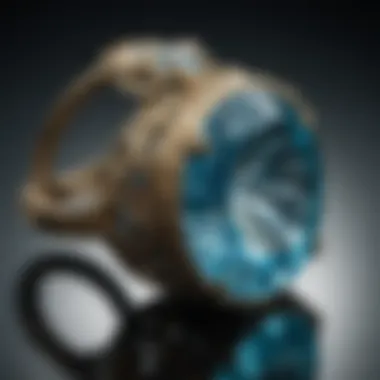
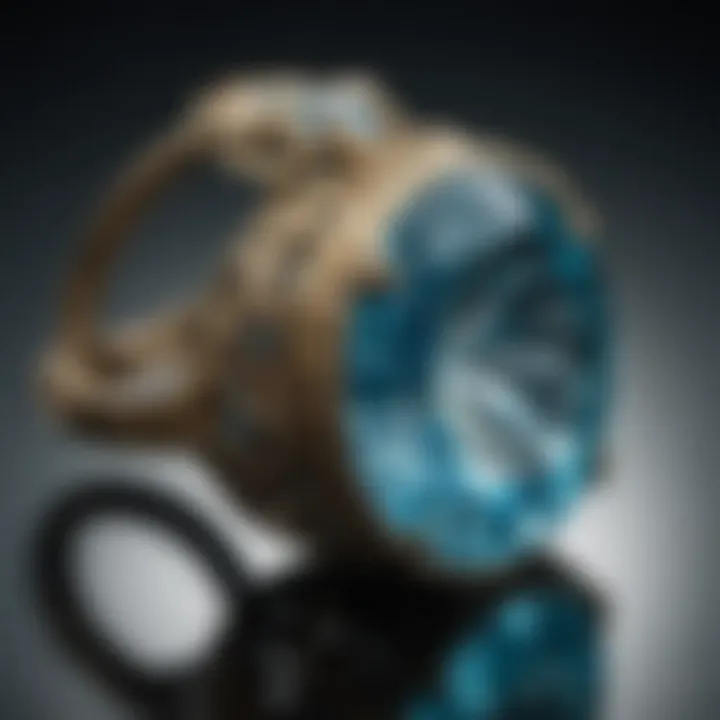
When selecting aquamarine, collectors often look for stones that are highly transparent with minimal inclusions. The stone’s color may also shift under different lighting conditions, which adds to its allure. Natural light can amplify the earthy feel, while artificial lights may wash out its hue. This characteristic of color variability emphasizes the importance of viewing aquamarine in various lighting when making a selection, especially for jewelry purposes.
Crystal Structure and Formation
Aquamarine is a member of the beryl family, sharing its composition with other notable stones like emerald and morganite. Its chemical formula is Be₃Al₂(SiO₃)₆, and it typically forms in pegmatites, which are coarse-grained igneous rocks. Understanding the crystal structure is vital for those interested in gemstone cutting and jewelry making. The absence of any significant cleavage means that aquamarine can withstand significant handling, making it great for everyday wear.
The crystals themselves can be quite large, sometimes exceeding several centimeters in length, exhibiting a hexagonal structure that perfectly displays its stunning color. Furthermore, this stone’s transparency allows for a greater range of light interaction, making it sparkle uniquely in jewelry settings.
"The natural beauty of aquamarine is not just in its color; it’s in the rarity of its formation and the crystal geometry of its being."
Given its origins, aquamarine isn’t just a mere stone, but rather a story of the slow geological processes that sculpted it over millions of years. Knowing how and where it forms can deepen one’s appreciation for aquamarine as more than just a material object, but rather a natural work of art sculpted by the earth itself.
In summary, the physical properties of aquamarine significantly affect its desirability and value, making an understanding of these factors crucial for every gemstone enthusiast and collector.
Historical Context of Aquamarine
Understanding the historical context of aquamarine unravels not just its beauty but also its profound ties to ancient cultures and traditions. This gemstone, prized for its serene blue shades, has traversed time and played various roles across civilizations. By exploring the beliefs and practices related to aquamarine, one can appreciate its significance in shaping jewelry customs and spiritual practices around the world. The stone has long been celebrated for its perceived protective qualities, believed to bring good fortune to those who wear it. Its vibrant color also evokes a connection to the sea, tying it to themes of tranquility and clarity, which makes it distinctly valued in both personal adornment and ceremonial settings.
Ancient Civilizations and Beliefs
Dating back to ancient times, aquamarine has found a special place in the hearts of many. The Romans were known to value the stone highly, associating it with the sea and sailors. They believed that by possessing aquamarine, one could ensure safe voyages. In fact, many sailors carried it as a talisman, convinced that it would protect them from stormy seas.
The Egyptians, too, held aquamarine in high esteem. It was often worn by pharaohs and used in burials, as it was thought to harness protective energies. Many believe that aquamarine served as a bridge between the realms of life and death, making it a staple in funerary practices.
In addition to these civilizations, the ancient Persian culture held profound respect for aquamarine. They regarded it as a stone of happiness and believed it brought peace and harmony to those who possessed it.
Aquamarine in Folklore
Aquamarine's significance stretches well into folklore across various cultures. Stories often highlight its connection to water, symbolizing clarity, serenity, and emotional healing. In many mythologies, aquamarine serves as a powerful symbol of calmness amidst chaos. For instance, sailors often turned to folk tales that spoke of mermaids and sea spirits, believing that aquamarine was indeed their favorite gem. It was said that mermaids would gift sailors aquamarine as a token of good fortune and protection while navigating unfamiliar waters.
Moreover, in medieval times, aquamarine was thought to enhance communication, particularly between lovers. Couples exchanged aquamarine stones in hopes of strengthening their bond, believing that it could resolve arguments and foster understanding. Such ideas solidified the idea of aquamarine not just as a gemstone, but as a conduit for emotional connection.
Thus, the historical context of aquamarine provides rich narrative threads linking the stone to beliefs about safety, love, and emotional well-being. Through these narratives, aquamarine has secured its place not only in the realm of gemstones but also in the hearts and minds of those who cherish its lore.
Cultural Significance of Aquamarine
Aquamarine's resonance with various cultures extends beyond its physical beauty. The allure of this gemstone lies not just in its color, but in the meanings and traditions that have grown around it over the centuries. People have not just admired aquamarine for its aesthetic value; they have also cherished it for its deeper significance, which often reflects the values and beliefs of the societies using it.
Aquamarine in Jewelry Traditions
From ancient times to modern-day fashion runways, aquamarine has secured its spot as a beloved gemstone in jewelry traditions. In many cultures, it is seen as a symbol of peace and tranquility. Take the Romans for example; they believed the stone held special powers, thought to ensure protection during sea voyages. Women of the time often wore it as a talisman, hoping for safe passage across turbulent waters.
In contemporary settings, aquamarine is increasingly favored for its calming blue shades, acting as a perfect complement to bridal jewelry. Its association with March also makes it a popular choice for those celebrating birthdays during that month. Wedding rings and engagement pieces embedded with aquamarine often symbolize loyalty and harmony, allowing couples to express their commitment in a unique and meaningful way.
"Aquamarine is not just a stone; it’s a message of longing and an emblem of commitment formed in the waves of time."
Unquestionably, cultural identity plays a huge role in how aquamarine is perceived and utilized. The artisans, who shape these stones into intricate designs, often usher in age-old traditions to their modern jewelry. This intertwining of past and present elevates aquamarine beyond mere decoration; it becomes a testament to the stories of the individuals wearing it.
Symbolism in Art and Literature
Across various art forms, aquamarine evokes a sense of calm and clarity, often depicted to represent hope and tranquility. Its blue tones hint at the vastness of the sky and the depth of the ocean, making it an ideal metaphor for the journey of life. In literature, aquamarine frequently shows up in poetic works, where it symbolizes everything from renewal to love. Writers have historically linked the color blue with wisdom and sincerity, attuning the stone well to themes of introspection and emotional fortitude.
Many artists, too, have drawn inspiration from aquamarine's serene color palette. Painters often incorporate it into works to evoke peace. Figuratively, aquamarine can represent a bridge between emotions, fostering serenity amidst chaos. For designers and thinkers, this stone delivers not only aesthetic pleasure but also a profound connection to artistic expression.
In summary, the cultural significance of aquamarine slices through time and tradition, connecting people through their shared appreciation for its beauty and the meanings they attach to it. The gemstone stands as a universal symbol; whether in jewelry or art, it speaks to the human condition in ways that are both simple and deeply intricate.
Metaphysical Properties
The metaphysical properties of aquamarine are both intriguing and significant, attracting attention not just from gemstone enthusiasts, but also individuals intrigued by holistic practices. Traditionally believed to hold calming energies, aquamarine’s attributes extend beyond mere aesthetics. This stone is often associated with clarity, courage, and a deeper connection with one’s own emotions, making it a favorite among those who engage with spiritual practices. As such, understanding these properties can enrich the appreciation and application of the stone in various aspects of life.
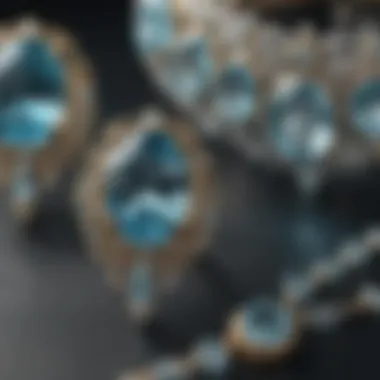
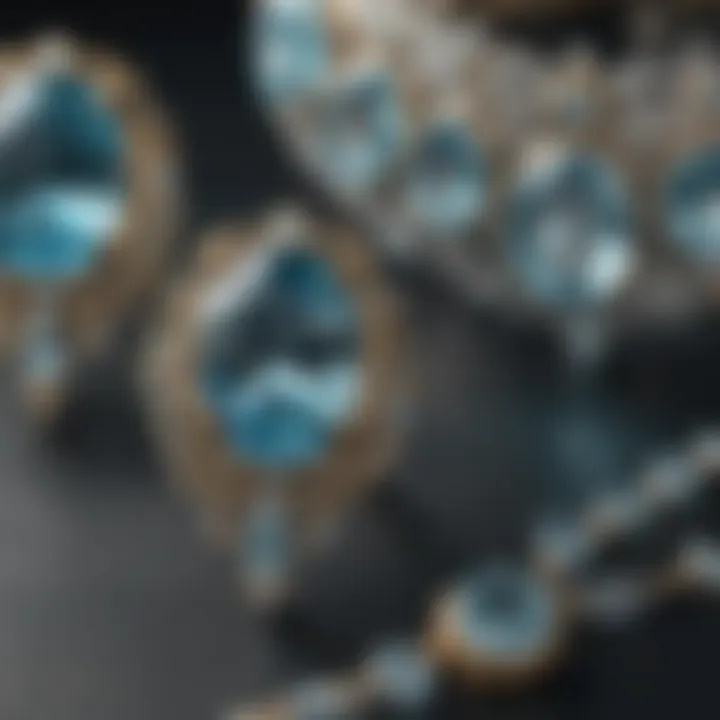
Healing Practices and Benefits
Aquamarine is often touted for its potential healing properties. Many suggest that it fosters emotional healing, encouraging a soothing environment conducive to personal growth. Here are some of the benefits believed to stem from aquamarine:
- Emotional balance: It helps in keeping emotional turmoil at bay, allowing users to express feelings without feeling overwhelmed.
- Stress relief: Its calming blue hue is said to encourage relaxation, making it excellent for meditation or mindfulness practices.
- Physical healing: Some practitioners tout benefits for ailments related to the throat or respiratory issues, asserting that wearing aquamarine can promote physical healing in these areas.
These elements make aquamarine unique not just as a decorative stone but as a tool for personal and emotional development. The practice of meditating with aquamarine can also deepen one’s connection to the self and to the universe, suggesting that its influence can transcend physical boundaries.
Meditative and Spiritual Uses
In the realm of meditation, aquamarine is often seen as a powerful ally. It is recommended for those looking to enhance their spiritual practices due to its reputed ability to promote tranquility and clarity of thought. Here are several ways aquamarine can be utilized in meditative and spiritual contexts:
- Meditation Stone: Hold aquamarine in your hand or place it on your heart while meditating to encourage deeper insights and serenity.
- Chakra Alignment: Aligning aquamarine with the throat chakra is common, as it is believed to aid communication and self-expression. This can often help in articulating thoughts and emotions more effectively.
- Emotional Release: Practitioners often incorporate this stone in sessions aiming to release pent-up emotions and achieve a state of peace.
"Aquamarine, with its tranquil blue color, acts as a visual reminder of the calm waters, guiding users towards inner peace and emotional clarity."
By integrating aquamarine into both meditative and daily activities, individuals may find themselves more equipped to handle the challenges that life presents, cultivating an approach rooted in serenity and self-awareness.
In summary, the metaphysical properties of aquamarine not only highlight its beauty but also its potential to serve as a valuable tool for healing and spiritual growth. Whether through personal practices or as a supportive element in one’s environment, aquamarine continues to inspire and assist many on their journeys.
Popular Varieties of Aquamarine
Aquamarine is not just a single gem, but a collection of stunning varieties, each captivating in its own right. Understanding the different types is essential. With various shades and a few features that help in identifying them, these diverse forms cater to different tastes and purposes. Knowing these varieties helps gemstone enthusiasts and collectors choose the right piece to fit their style or needs. It also enriches the narrative surrounding aquamarine—more than a stone, each variety carries individual stories and characteristics.
Different Shades and Types
When it comes to aquamarine, color plays a prominent role. The name itself hints at its blue hue, derived from the Latin for "water of the sea." However, this stone can be found in a variety of shades that range:
- Light Blue: This is the most common hue, resembling the serene waters of a tropical beach. Generally associated with calmness, it appeals to those who appreciate subtlety.
- Deep Blue: A more striking option, deep blue aquamarine displays a saturation that can rival sapphire. This kind often fetches a higher market price due to its rarity.
- Greenish Blue: Sometimes, you may come across stones with a hint of green, adding a unique twist to the traditional color. This variety is often considered less desirable but has its own enthusiasts who appreciate its distinctiveness.
The type of aquamarine you choose can signify different qualities. For example, light blue aquamarine is said to embody tranquility, while the deeper hues can symbolize wisdom and clarity. The presence of iron during the stone's formation process largely influences these color variations.
Distinguishing Features of Notable Varieties
Not every aquamarine is created equal. Certain notable varieties exhibit distinguishing features that set them apart. Here's a closer look at some of them:
- Brazilian Aquamarine - Known for its clarity and vivid hues, these stones often originate from Minas Gerais, a region famed for premium quality gemstones. Well-cut Brazilian aquamarines can showcase incredible brilliance and depth.
- African Aquamarine - Generally darker in hue, African aquamarine has a unique charm. Found primarily in Nigeria and Madagascar, this type may show more intensive color saturation, making them more visually striking.
- Russian Aquamarine - Emerging predominantly from the Ural Mountains, Russian aquamarines are sometimes recognized for their exceptional size. This makes them sought after for large statement jewelry pieces. They typically display a light blue shade that appeals to traditional standards.
- Welsh Aquamarine - Less common, Welsh aquamarine contains natural inclusions that can add character to the stone. These inclusions often tell a story of the stone's journey through time, which can captivate those with a keen interest in geology.
Aquamarine> isn't simply a beautiful jewel; it encapsulates various shades and types, each presenting its own appeal and story. By understanding these popular varieties, both casual admirers and serious collectors can gain a richer appreciation of this captivating stone, leading to informed choices when it comes to buying or wearing aquamarine jewelry.
Care and Maintenance of Aquamarine
Proper care and maintenance are paramount when it comes to preserving the beauty and integrity of aquamarine. This gemstone, revered for its soothing blue hues and associations with tranquility, requires a thoughtful approach to ensure that its luster endures through the years. Understanding how to care for aquamarine not only enhances its beauty but also sustains its value as a treasured piece in your collection.
For gemstone enthusiasts and collectors alike, taking the time to learn about proper maintenance can make all the difference. Aquamarine is relatively durable, rated 7.5 to 8 on the Mohs scale, which indicates a fair resistance to scratching. However, like any natural stone, it can be susceptible to certain chemicals and extreme conditions. By adopting simple cleaning methods and adhering to effective storage recommendations, you can ensure that your aquamarine remains vibrant and enchanting.
Cleaning Methods
When it comes to maintaining the clarity and brilliance of aquamarine, adopting the right cleaning methods is key. Here are several effective techniques:
- A gentle soap solution: Mix a few drops of mild dish soap with warm water. Soak a soft cloth or a soft-bristled toothbrush in the solution and gently scrub the gemstone. Rinse thoroughly with clean water and dry with a soft, lint-free cloth.
- Avoid harsh chemicals: It’s crucial to steer clear of bleach or ammonia-based cleaners, as these can affect the stone’s finish. Similarly, ultrasonic cleaners can be too harsh for aquamarine and should be avoided in favor of gentler methods.
- Steam cleaning: A safe method for many gemstones, a gentle steam cleaning can help remove dirt and grime without damaging the stone. Always keep the steam source several inches away from the gem to prevent any heat shock.
"Cleaning your aquamarine piece with care preserves its charm and ensures it sparkles like the day you bought it."
Incorporating routine cleaning into your jewelry maintenance routine—aiming for every couple of weeks—will help prevent buildup of dirt and oils that can dull its shine.
Storage Recommendations
Proper storage is just as essential as cleaning when it comes to upkeep. Aquamarine's beauty can be compromised if not stored under appropriate conditions. Here are some storage tips to consider:
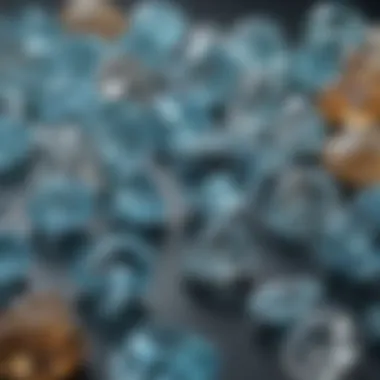
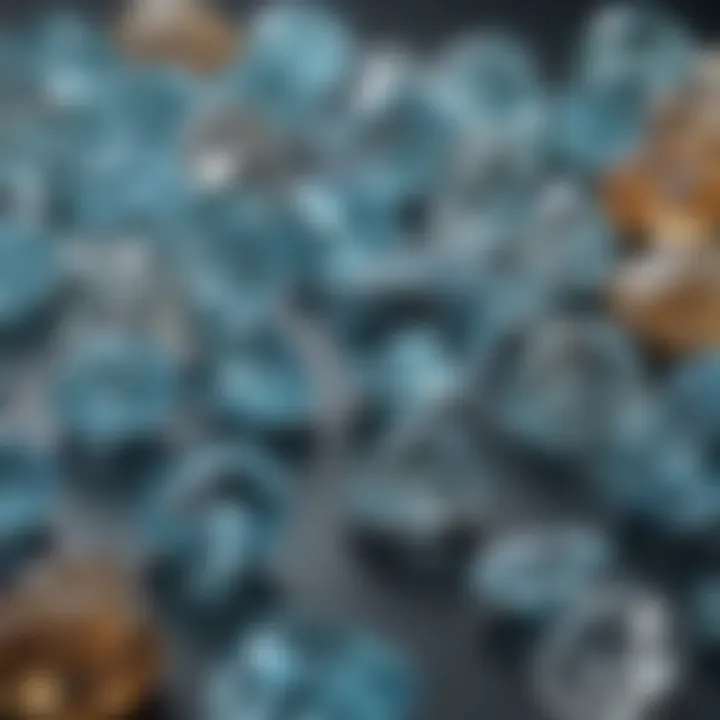
- Keep it separate: Always store aquamarine in a fabric-lined box or pouch, distinct from other gems and jewelry. This minimizes the risk of scratching from harder stones and keeps it safe from abrasives.
- Avoid intensity of light and heat: Prolonged exposure to direct sunlight or high heat can lead to color fading over time. It’s advisable to store your aquamarine in a cool, dry place away from sunlight.
- Humidity control: High humidity can lead to undesirable conditions for any gemstone. Use silica gel packets in storage boxes to control moisture.
These simple yet effective care tips will extend the life of your aquamarine, allowing those who own it to appreciate its charm for many years to come.
Ethical Considerations in Sourcing
In the realm of gemstones, the spotlight often shines on the beauty and allure of each stone, but equally important is how these natural treasures are sourced. Ethical considerations in sourcing aquamarine are vital not only for the integrity of the stone itself but also for the people and ecosystems involved in its extraction. As this topic gains traction, both consumers and collectors alike are becoming increasingly aware of the implications of their purchases. Understanding these ethical dimensions can help ensure that one's choices positively impact both the environment and society.
Sustainability in Gemstone Mining
Sustainability in gemstone mining is a crucial factor that underpins responsible sourcing practices. This approach emphasizes the need for extracting resources while minimizing harm to ecosystems and supporting the communities involved in mining activities. Mining aquamarine sustainably means more than just limiting ecological damage; it's about ensuring equitable practices that benefit local populations.
One way to establish sustainability in aquamarine mining is through the implementation of environmentally friendly practices, such as:
- Reducing Water Usage: Traditional mining techniques can consume vast quantities of water. Employing methods that recycle and reduce water usage can mitigate this impact.
- Habitat Preservation: Protecting local wildlife habitats during the mining process is essential. Sustainable operations often engage in reforestation efforts and land rehabilitation once mining is completed.
- Use of Modern Technology: Employing newer technologies can lead to more efficient mining, minimizing waste and environmental disruption.
The benefit of such practices is manifold. Not only do they help preserve the environment, but they also foster goodwill and support for local communities by providing stable jobs and investing in local development. This way, aquamarine can be more than just a beautiful stone; it can symbolize a commitment to ethical progress.
Fair Trade Practices in Aquamarine Trade
The concept of fair trade resonates strongly in the gemstone industry, particularly concerning aquamarine. Ensuring that miners and traders receive just compensation for their labor is paramount in establishing a fair market. Fair trade practices help create transparency within the aquamarine trade, allowing consumers to make informed decisions when purchasing jewelry or loose stones.
Preferences for fair trade aquamarine often include elements such as:
- Transparent Supply Chains: Knowing where and how the aquamarine is sourced gives customers confidence and insight into the ethical implications of their purchases.
- Living Wages for Workers: Fair trade practices often advocate for equitable wages, allowing miners and their families to thrive rather than merely survive.
- Community Investment: Engaging with local communities to ensure they benefit from the aquamarine trade is vital for fostering long-term relationships built on trust and mutual respect.
"Supporting fair trade is more than a choice. It's a commitment to integrity and social responsibility in the gem industry."
Aquamarine in Modern Jewelry Design
Aquamarine has carved out a significant niche in modern jewelry design. Its tranquil blue hue, reminiscent of clear ocean waters, resonates well with both designers and consumers. This stone is not just a pretty face; it brings with it a sense of sophistication and a touch of nature that appeals widely.
The importance of aquamarine lies not only in its aesthetic beauty but also in its versatility. Designers can work with various shades, from the faintest blues to deeper sea tones, making it suitable for a variety of styles and settings. By innovatively incorporating aquamarine into their designs, jewelers create pieces that are both timeless and contemporary.
Trends in Contemporary Jewelry
In the world of jewelry, trends come and go like the tide. However, aquamarine has been part of some significant trends in recent years. Here are a few of them:
- Minimalist Designs: The drive towards minimalism has allowed aquamarine to shine in simpler settings, often surrounded by sleek geometric lines. This approach lets the stone’s clarity and color take center stage.
- Mixed-Materials: Designers are increasingly blending aquamarine with other materials. For example, pairing it with gold or silver creates a beautiful contrast that enhances its cool tones.
- Sustainable Practices: A rising trend in ethical jewelry sourcing has made aquamarine, particularly from responsible mines, a sought-after choice for conscientious consumers.
These trends indicate a growing appreciation for aquamarine as more than just a traditional stone; it finds a place in innovative and artistic expressions of modern jewelry.
Notable Designers Incorporating Aquamarine
Several prominent designers have made their mark by using aquamarine. From signed pieces to bespoke designs, their work showcases the stone's beauty and versatility. Some notables include:
- Irene Neuwirth: Renowned for her bold and colorful approach to jewelry, Neuwirth often uses aquamarine in her pieces, capturing the dreamy essence of the stone in various styles.
- Anna Hu: A prominent designer in the luxury jewelry sector, Hu has a distinctive style where she often combines aquamarine with rare gemstones, crafting one-of-a-kind pieces that stand out.
- David Yurman: Known for his luxurious designs, Yurman appropriately uses aquamarine as a central piece in many of his collections, showcasing its beauty in intricate settings.
Each of these designers brings a unique perspective to aquamarine's potential, illustrating its ability to adapt and flourish in a variety of design philosophies. The inclusion of aquamarine in their collections signifies both a trend and a testament to the stone’s enduring appeal.
"Aquamarine has become a hallmark of elegance and creativity in modern jewelry, representing not just a gemstone, but a story woven through design and emotion."
As seen, aquamarine's integration into modern jewelry design reflects a broader cultural appreciation for these stunning stones, combining art, nature, and personal expression.
Epilogue
As we bring this exploration of aquamarine to a close, the significance of this gemstone becomes crystal clear. Not only is aquamarine celebrated for its striking blue color, but its historical and cultural relevance also speaks to its enduring charm. This article has highlighted various aspects of aquamarine—its beauty, its use in jewelry, its metaphysical properties, and the ethical considerations surrounding its sourcing. These points underscore the multifaceted nature of aquamarine, from being merely a gemstone to a symbol of tranquility and strength.
Summation of Aquamarine's Importance
In essence, aquamarine stands out in the realm of gemstones for several reasons:
- Cultural Heritage: It boasts a rich history tied to ancient civilizations. The Romans believed aquamarine was a gift from the sea goddess, which is fondly reflected in its name.
- Metaphysical Benefits: Many view aquamarine as a stone that fosters clear communication and emotional balance. These properties resonate deeply with individuals seeking both beauty and serenity in their lives.
- Contemporary Trends: In the modern jewelry scene, aquamarine is making waves with its versatility and trendiness. Designers often incorporate this stone to create stunning pieces that captivate the eye while serving as a conversation starter.
Ultimately, the lessons learned from the intricate details surrounding aquamarine emphasize its allure not just for collectors and enthusiasts, but also for individuals drawn to its deeper, spiritual meanings. This gemstone is a reminder that beauty can extend beyond the physical realm, influencing how we express ourselves and connect with our surroundings. In a world where authenticity is treasured, aquamarine shines brightly as a beacon of clarity.



